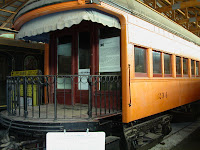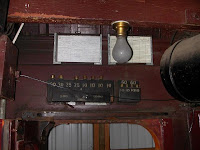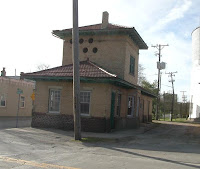
This bridge in Urbana was part of the IT's freight bypass around Champaign-Urbana. The rest of the line is pretty much obliterated.

This was the Railway Engineering lab at one time; it had a track entrance through this door for a spur off the old IT main line, which ran through the foreground. The University's interurban test car was stored here. It's long been used as an aeronautics lab. The overhead crane is still inside.

The Transportation building next door is decorated with these snazzy flanged wheels and wings.

A couple of waiting shelters still in existence: 1) for the University. At one time a car line ran right across the Quad.

2) For the old County Home east of downtown Urbana.

One of the earliest ancestors of the ITS system was the horsecar line between Urbana and Champaign. The only remaining part of this little system is this bridge over the Boneyard. I believe this part of the route was abandoned when the line was electrified, so the bridge's survival is amazing. It was in somebody's back yard for many years.

It's been refurbished and is now part of a city park. The layout of the park completely changed the landscape. The creek doesn't actually run under the bridge anymore, and the fill over it has been removed. But it's nicely preserved.
Bloomington


Two recent photos by Tim Fennell.


2007 pictures by
Jim Vaitkunas.
(L) This is a diamond in the rough.





Danvers


Pictures taken in 2007 by Jim Vaitkunas.
The substation at Danvers is now in use as a private residence.



Decatur

The abutments for the IT's famous bridge over beautiful Lake Decatur are still standing. June 2009.

The Decatur station along the freight bypass route is now in use as a church.
Harristown

Harristown is the next town west of Decatur. Here is the substation, now being used as a furniture store, with the body of car 535 behind it, used as a residence. May 8, 1998.

It doesn't look that much different today, I believe.
Here are several pictures of the IT main station in Springfield. These were all taken by
Tom Hunter in April/May 2013, shortly before the building was demolished.







Girard


This substation is now in use by a gardening supply store. Notice (R) that the rails are still in the street, for a couple of blocks through town.


For an in-service picture at this same location, see the top photo
here!
Fithian


Pictures taken in 2007 by
Jim Vaitkunas.
Mackinaw


Pictures taken in 2007 by Jim Vaitkunas.
Where'd all those trees come from? They sure weren't there when this famous substation was in service!


The Mackinaw sub is used by several businesses and is well maintained.
Pictures taken in 2012 by
Chuck Amstein.
Union


Just to keep everyone confused, there are (at least) three Unions in Illinois. This is the one in Logan County along the IT. It's about 170 miles south of IRM's Union in McHenry County.


The Union sub is abandoned and derelict.
Pictures taken in 2012 by
Chuck Amstein.


IVDIV
(East to west)
Minooka


Here is the Minooka substation,which is still in use by a machinery company (and possibly as a residence?) It's located on Wapella Street. I now regret not taking pictures of the Wapella substation before it was demolished four or five years ago. (Wapella is between Decatur and Bloomington.)

Bridge abutments for a small creek just west of Minooka.
Morris


The Morris sub is partly a pizza place, and partly empty, it appears. Tenants come and go. Adaptive reuse is the only thing that keeps these buildings from being razed. The two buildings are nearly identical except for the revolting paint.

A few blocks west of the substation is this bridge over another creek, with a park path over it.
Marseilles


This is the hydroelectric plant at Marseilles. (L) The south (river) side; (R) the north side.


Details of the north side. The trestle in front of the plant appears to still have rails on it, but there's no way to get closer. The area is fenced off and dangerous.

Canal Bridge at Ottawa (Sept. 1980)


The Illinois and Michigan Canal crossed the Fox River at Ottawa on this bridge. When the canal stopped operating, the IT's Illinois Valley Division relocated onto the old towpath.

Here's where the track ran. The trolley wire supports are still in place. A bicycle/hiking path has been built here, but otherwise the bridge is largely unchanged since 1980.
So let's imagine piloting the 415 on this route!

This is the canal part of the bridge. They say it's the largest bridge of its type in the world.
Ottawa


This building at one time housed the CO&P ticket office on the ground floor and company offices on the second floor. The ground floor, at least, has been heavily remodeled.
Utica


The battery sub at Utica, which of course hasn't moved but is now in somebody's back yard.

This must really impress any guests -- who else has something like this in their yard?
PRESERVED ROLLING STOCK
Car 101

At Fehling Road in Granite City, Nov. 13, 1949. Photo by George Krambles, Krambles-Peterson Archive.

At Wood River, Oct. 11, 1952. Photo by William C. Janssen, Krambles-Peterson Archive.
Car 234


Let's take a tour of the IT business car 234. This is the only surviving product of the Danville Car Company, and one of only a few interurban observation cars preserved. Let's start at the rear and work our way forward.
Here's the rear platform. President Taft stood here while campaigning for reelection in 1912.


Through the open door, we enter the main compartment. There are parlor car chairs for about ten people, plus tables for drinks and snacks.

Notice the rods in the ceiling, so curtains could be hung to provide additional sleeping space in emergencies.

Further forward, there are sections that can be set up either for sitting or sleeping. However, unlike Pullman sections, the upper berth is created by folding up the seat backs, which are hinged at the top, and installing a steel rod to hold them horizontal, as seen here.


Let's look into the tiny kitchen compartment, just big enough for one man. So it's hard to get good pictures. On the left is the sink and metal countertop, with the ice box above it. On the right is the coal-fired stove.


Here's the rear platform, one side of which has the hot-water heater compartment. Watch your step as you exit via the front stairwell.
Car 241


This was the earliest piece of IT equipment selected for historic preservation, I believe, and one of the earlier interurban cars preserved. It is now stored under cover at MOT near St. Louis.
Photos 7/11/09 by
Frank.
Car 277
This is a standard IT combine, built by St. Louis Car Co. in 1913, preserved at IRM, the only one of its kind.

E. Peoria c. 1952, photo by William C. Janssen, Krambles-Peterson Archive. Note the ex-C&LE freight trailer the 277 is towing.

At Danville, Apr. 20, 1952. Photo by Henry M. Stange. Krambles-Peterson Archive.

At E. Peoria, Aug. 22, 1952. Photo by George Krambles, Krambles-Peterson Archive.

Meeting the 276 at Chatham, Oct. 12, 1952. Photo by William C. Janssen, Krambles-Peterson Archive.

At North Chicago, Sept. 1956. Photo by Glenn Andersen. Krambles-Peterson Archive.


Here we see it in operation in September 2008.

Let's take a look inside the cab. One at a time, please, there's not much room here. First we see the controller and brake stand, as well as the hand brake on the right.

The supplemental reservoir for the M-22A brake valve is located inside the cab over the motorman.


And here's one of my favorite features on the 277: the reverse lever (red arrow). What do you do if the air brake system fails? Reverse the motors by throwing the reverser. On multiple unit (MU) cars, the reverser is located under the car and is thrown electrically. But what happens if you have also lost DC power, such as if the pole has dewired? On the North Shore or CA&E cars, you'd be out of luck. So the IT installed a home-made mechanical linkage to the reverser. The motorman could pull back on this lever and throw the reverser in an emergency.

Now let's look at some of the interior. Here's the water heater compartment. The coal scoop is on the door, and at the lower left is the steel box which still holds IT company coal. To the right is the Peter Smith hot water heater.

At the rear of the main compartment, the last seat has a desk for the conductor to do his paperwork on. There are four slots, but they're not labeled, so I don't know exactly what they're for.

It would be nice to have some cold water. Ah, here's the spigot. But what's behind that door above it?

That's strange, it's just another door. It says "ICE HERE".

It folds out and down, instead of to the side, and look, it's an official "Ice Door" made by the H G Co., whoever
they were.


Then here we have the thermostat , first aid box, and controls for the car's primitive air conditioning system, c. 1940.

Inside the washroom compartment, on the right we see the back of the ice box we looked at earlier. (On top of it is a loose piece of wood, not part of the system.)

And finally, here's some sage advice from Illinois Terminal. The town you flush in might be your own!
Car 415

On the viaduct at St. Louis, Dec. 22, 1956. Photo by Bob Mehlenbeck, Krambles-Peterson Archive.
Car 518

See the detailed car history
here. This is the interior as of Oct. 2008.

Most of the interesting features on this car are at the front end (which would usually have been the rear end on the IT.) Here's the wreck tool box over the vestibule door.

This is the Peter Smith water heater. Originally there was a wooden partition between the heater and the seat; this seems to have been removed when the car was in use as a classroom. We have the original drawing, and I plan to build a new one when I get a chance.

The stained glass window in the toilet compartment is still there, although covered over by the exterior sheet metal. You can barely see it in this photo.

It's difficult to take a picture of such a small room. It's in good condition, and used for storing spare items such as an oil can.
Locomotive 1565

Victor gave me a copy of this hand-colored postcard of the brand-new 1565 pulling a freight train back in ITS days.

At Forsyth c. 1953, photo by William E. Robertson, Krambles-Peterson Archive.
Locomotive 1575

Preserved at MOT in St. Louis. Photo 7/11/09 by
Frank.
Line Car 1702
Don't be embarrassed if you don't know what a line car is. Back in 1960, when this car was acquired for the Museum, it was to be sent on its own wheels over the railroads to North Chicago. But nobody on the major lines such as IC or C&NW had any idea what a "line car" was or what it might look like. So it got lost, being shuffled from yard to yard as the various yardmasters wondered "What in the world is
this thing?!?" So Bob Bruneau got on the phone and started calling around. Finally he got the reply, "Well, we've got this thing that looks like a house on one end and a porch of some sort..." "THAT'S IT!!!" he shouted. "It's supposed to go to North Chicago!"

Photos from the IRM Collection.


Answer to the riddle: This car is equipped with everything needed for working on the overhead lines, such as a movable platform on the roof, ladders, wire reels, and tools of all sorts, hence "line car."
Rail Bus

This, of course, is the Illinois Terminal's little rail bus #206, which provided service to Grafton. It's now on display at MOT near St. Louis. Photo by
David Wilkins, taken in January 2005 right after completion of a cosmetic restoration. It was then placed under cover, where it is now on display.
PAPER
All of the documents displayed here come from the
Robert E. Bruneau Illinois Terminal Collection unless otherwise noted.

The Illinois Terminal hopefully started showing off its new streamliners in the fall of 1948. There was a brief epidemic of optimism about passenger service among many railroads immediately after the war, but the IT was the only interurban line to be infected.


Advertising flyers, about 6 x 10.


Oops, there must be something wrong with these new trains....


A couple of 5 1/2 x 7 calendar cards.
 It was sunny again today, so I took the opportunity to put a first coat of primer on all the exposed roof boards on the 277. The solar panels on the roof of the barn work pretty well. Here we see it when done. I'll want to put on a second coat of primer and probably some sort of finish coat. It then gets covered with roofing paper before the canvas goes on.
It was sunny again today, so I took the opportunity to put a first coat of primer on all the exposed roof boards on the 277. The solar panels on the roof of the barn work pretty well. Here we see it when done. I'll want to put on a second coat of primer and probably some sort of finish coat. It then gets covered with roofing paper before the canvas goes on. Now that I have all of the new seat frame castings drilled, let's see if they will really work. Here is one of the broken castings on a seat in the 309, after removal of the cushion and back. The arrow points to the missing piece of the track. The bracket for the seat back derails whenever it reaches this spot.
Now that I have all of the new seat frame castings drilled, let's see if they will really work. Here is one of the broken castings on a seat in the 309, after removal of the cushion and back. The arrow points to the missing piece of the track. The bracket for the seat back derails whenever it reaches this spot. I removed the entire seat frame at this location. Here it is standing on end, with the broken casting removed (at the top). A test fit verified that the new casting will work just fine. But this particular seat has more than one problem. There are two arms (yellow arrows) connected to the center rod (red arrow). These arms mesh into the brackets on the seat back and should keep it straight. But one of them is bent, and the other is loose on the rod - notice that they don't line up the way they should. I will disassemble this frame and take the center rod assembly to the shop to be fixed by our metal-working experts.
I removed the entire seat frame at this location. Here it is standing on end, with the broken casting removed (at the top). A test fit verified that the new casting will work just fine. But this particular seat has more than one problem. There are two arms (yellow arrows) connected to the center rod (red arrow). These arms mesh into the brackets on the seat back and should keep it straight. But one of them is bent, and the other is loose on the rod - notice that they don't line up the way they should. I will disassemble this frame and take the center rod assembly to the shop to be fixed by our metal-working experts. Between a seat frame and the wall I found this little relic of Tag Day 1939. It's a piece of cardboard about 3" square. On the back it just says "Thank You". I think the missing word is probably "Charities" and that this was some sort of annual fund raiser. Does anybody remember Tag Day?
Between a seat frame and the wall I found this little relic of Tag Day 1939. It's a piece of cardboard about 3" square. On the back it just says "Thank You". I think the missing word is probably "Charities" and that this was some sort of annual fund raiser. Does anybody remember Tag Day?




























































































































































